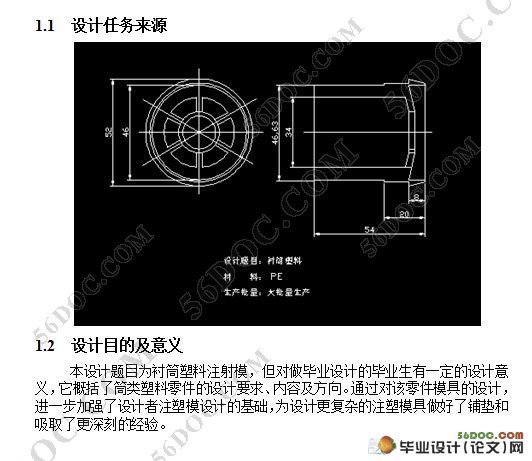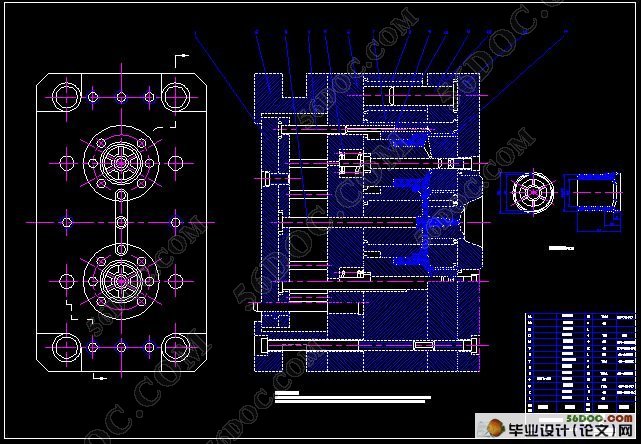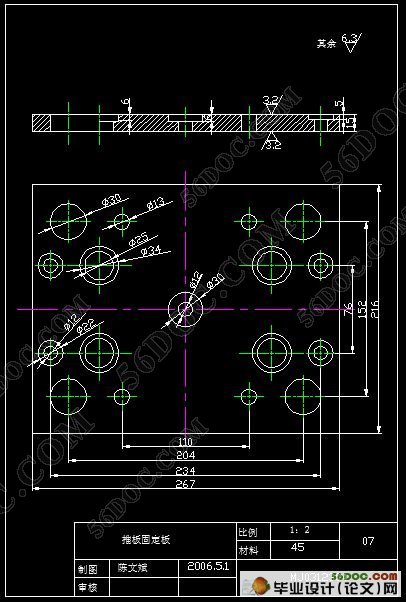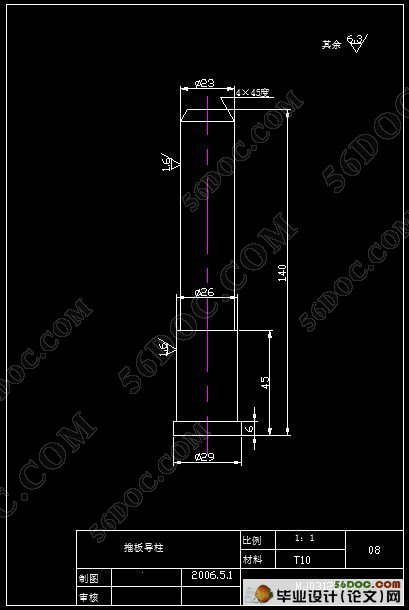衬筒的成型工艺及模具设计
无需注册登录,支付后按照提示操作即可获取该资料.
衬筒的成型工艺及模具设计(含任务书,开题报告,中期检查报告,毕业论文说明书9000字,cad图纸9张合一)
摘 要
此设计题目为一个衬筒注射模,此塑件在技术要求方面要求不高,所以模具设计的精度也不需要太高。通过对不同设计方案的对比,最终确定设计方案为:
(1)分型面选在零件对称面的地方;(2)模具设计为一模两腔式的制件布局;
由于设计的能力有限,设计过程中还存有许多不足之处,但经过精确的计算和校核,此套模具能够加工所需的合格制件,再加上制件的精度要求不是很高,所以此模具可以投入生产使用。
关键词: 分型面 一模两腔 潜伏式浇口
Canister and die design of coil frame
Abstract
The topic of this design is a coil framework.The request of this plastics in the aspects of technique requesting is not high, so the accuracy of the molding tool design also does not request too high. Pass to the contrast of the different design project, end certain design project is: (1) The cent type chooses is the place of the 5 mm in the spare parts high degree; (2) the type of molding design is a mold two the system a distribution; (3) the molding adopted the inclined leading the pillar side take-out organization.
Because designing the ability limited, there are still many not enough places in the design process. But through accurate calculation, this set of molding tools can process a qualified the piece of system for needing. Plusing the accuracy of the piece of system request is not very high, so this molding tool can be using in the production.
Keyword : partsurface a mold two the system lurk moulding
本塑件的材料是低密度聚乙烯,属于热塑性塑料,从使用性能上看: 低密度聚乙烯由于含有较高的分子量、密度及结晶度,因此质地坚硬、耐寒性能良好,在-70℃ 时还保持柔软。化学稳定性很高,能耐酸碱及有机溶剂。吸水性极小,有很突出的电气性能和良好的耐辐射性,用火焰喷涂法或静电喷涂法涂于金属表面,可以达到减摩和防腐蚀的目的。缺点是力学强度不高,热变形温度很低,故不能承受较高的载荷。
从成型性能上看:该材料流动性好,吸湿性小,吸水率小于0.01%,因此可不考虑干燥,但由于其收缩率很大以及其在相互垂直的两个方向的收缩率差异更显著,易引起制品翘曲等缺陷。又由于收缩率还和制品厚度有关,应严格控制制品壁厚差异,以保证成型质量。




#p#副标题#e#
目 录
绪论.............................................1
第一章 任务来源及设计目的意义....................5
1.1设计任务来源..............................5
1.2设计目的及意义............................5
第二章 零件的工艺性分析..........................6
塑件的原材料分析..........................6
塑件的结构和尺寸精度及表面质量分析........6
计算塑件的体积和质量......................7
塑件注塑工艺参数的确定....................7
第三章 工艺方案的确定 ..........................8
分型面选择................................8
确定型腔的排列方式........................8
浇注系统的设计............................9
第四章 成型零件结构设计.........................13
凸凹模的结构设计............................13
型腔和型芯工作尺寸计算....................13
第五章 模具设计的有关计算........................15
型腔侧壁厚度和底板厚度计算................15
模具加热与冷却系统的计算..................15
第六章 模具闭合高度和注塑机有关参数的校核.......17
第七章 编写主要工作零件加工工艺规程.............18
型芯的加工工艺............................18
型腔加工工艺..............................18
总结.............................................20
致谢.............................................21
参考文献.........................................22
